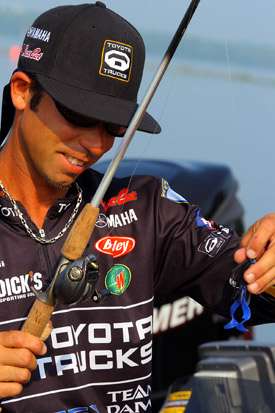
In the first two parts of our equipment series we looked at Kevin VanDam’s recommendation for three basic bass fishing rods (KVD Helps You Choose a Fishing Rod) and Skeet Reese’s recommendation for reels to mount on those rods (Reese Gets Reel). Now, let’s see what 2003 Bassmaster Classic Champion, Mike Iaconelli, has to say about line and what anglers should be using.
“Before we get started I’d like to say I’m glad to see an article about line,” says Iaconelli. “There are plenty of articles about rods, reels, lures and places to fish but not nearly enough about line. It’s every bit as important as anything we fish with. It’s a serious subject. It doesn’t get enough attention. “
He suggests that anglers spool their three reels with three different types of line — braid and monofilament for casting applications and fluorocarbon for spinning applications. Each has its place in bass fishing.
“On your heaviest outfit you’ll be doing everything from spinnerbaiting in heavy cover to pitching and flipping mats. Under those conditions you need something that’s strong, abrasion-resistant and has no stretch. You want to set the hook immediately and then be able to move big fish out of heavy cover quickly.
“Spiderwire — 65-pound test — will do the job. Their advertising says it’s ‘tough as nails’ and they’re right. It’s the best all around heavy cover line available today.”
On the other casting reel, mounted on the lighter rod, Iaconelli advises anglers to use monofilament, specifically green 14-pound-test Berkley Sensation.
“For lighter cover and some lures you’ll want something that’s tough and abrasion-resistant but still has some stretch to it. A little give is important, especially with lures that carry treble hooks such as topwater baits, crankbaits and smaller swimbaits. In my opinion Sensation is the best.”
On spinning outfits, the Runnemede, N.J., pro recommends fluorocarbon.
“You always want at least one spinning outfit in the boat. At some point bass will get tough to catch, and there will be a zillion boats in front of you. For that you’ll probably want to finesse, and there’s nothing better than 8-pound-test Berkley Trilene 100% Fluorocarbon.
“It’s completely invisible while at the same time tough. It’s also flexible enough for spinning applications. But, the most important reason to use it is because it’s dense and sinks. That translates into more action on small lures, which is what you always want — almost always anyway.”
Iaconelli continues by offering these additional tips for getting the most out of your line:
1. Always fill about 1/4 of your spool with backing. Ike recommends old line but doesn’t recommend tying it to your new line.
“Tie the backing off with a couple of overhand knots and clip it as close as possible. Then spool your new line. The idea is to increase the diameter of the spool with old line and therefore use less good line. That’ll save a ton of money over the course of a fishing season.”
2. Use line dressing or conditioner. Ike recommends soaking a cloth with it and then running your new line through the cloth as you spool it. After that, apply dressing or conditioner as required to keep the line pliable.
“I like Reel Magic and Kevin VanDam’s Line and Lure Conditioner. They both do a good job. Conditioner is important. Don’t neglect it. It makes a lot of difference in line performance.”
3. Check your line constantly for problems and retie frequently. Ike recommends checking it every few minutes throughout the day.
“I suggest anglers retie or replace their line anytime there’s anything different about it. I usually run it between my fingers. If I feel anything different — not just nicks or scuffs — I retie or replace. Nothing is as frustrating as losing a big bass because of poor line quality.”
4. Braid is expensive. Ike recommends swapping it end for end to hold down the cost.
“After you’ve been fishing for a few days, strip the braid off your reel and reverse it. Use the end that was the fishing end against the spool and the end that was against the spool as the fishing end. This won’t hurt a thing and you’ll get double duty out of your line.
“But, don’t do this with monofilament or fluorocarbon. It doesn’t work. You’ll have a mess. It only works with braid.”




